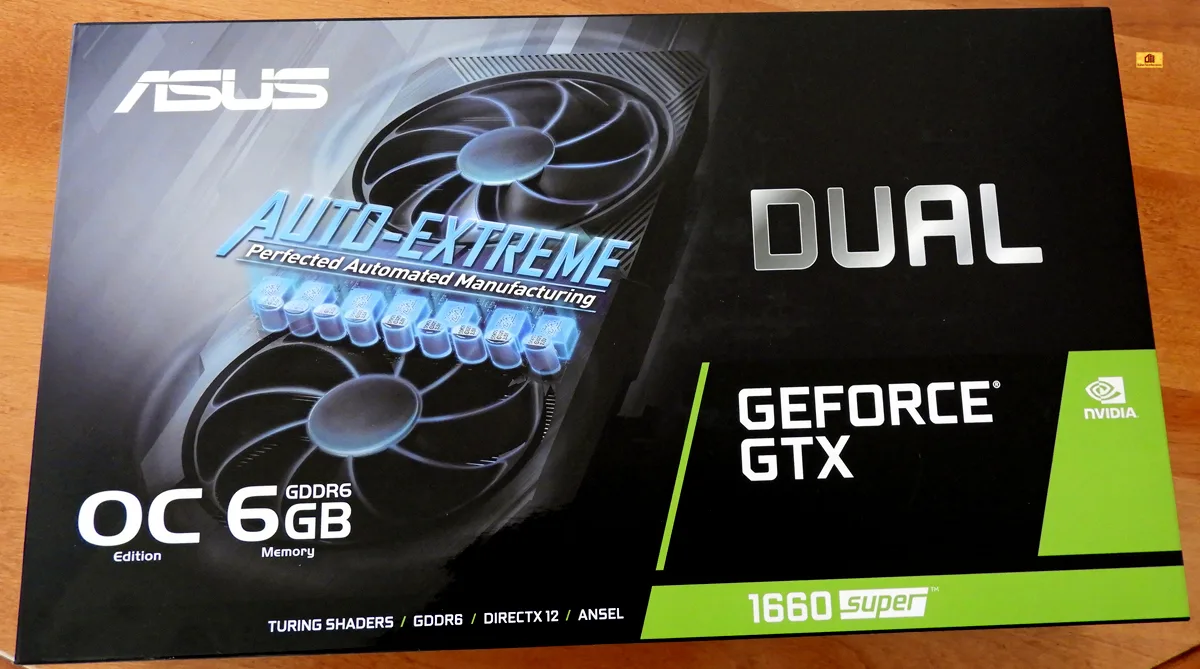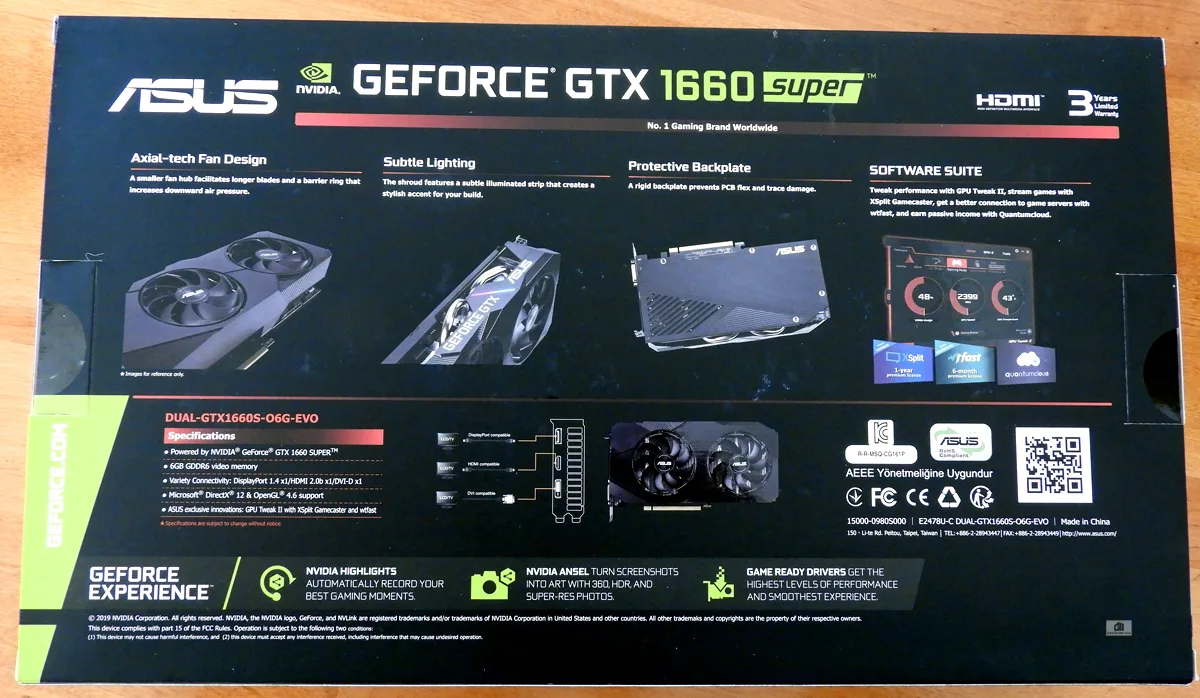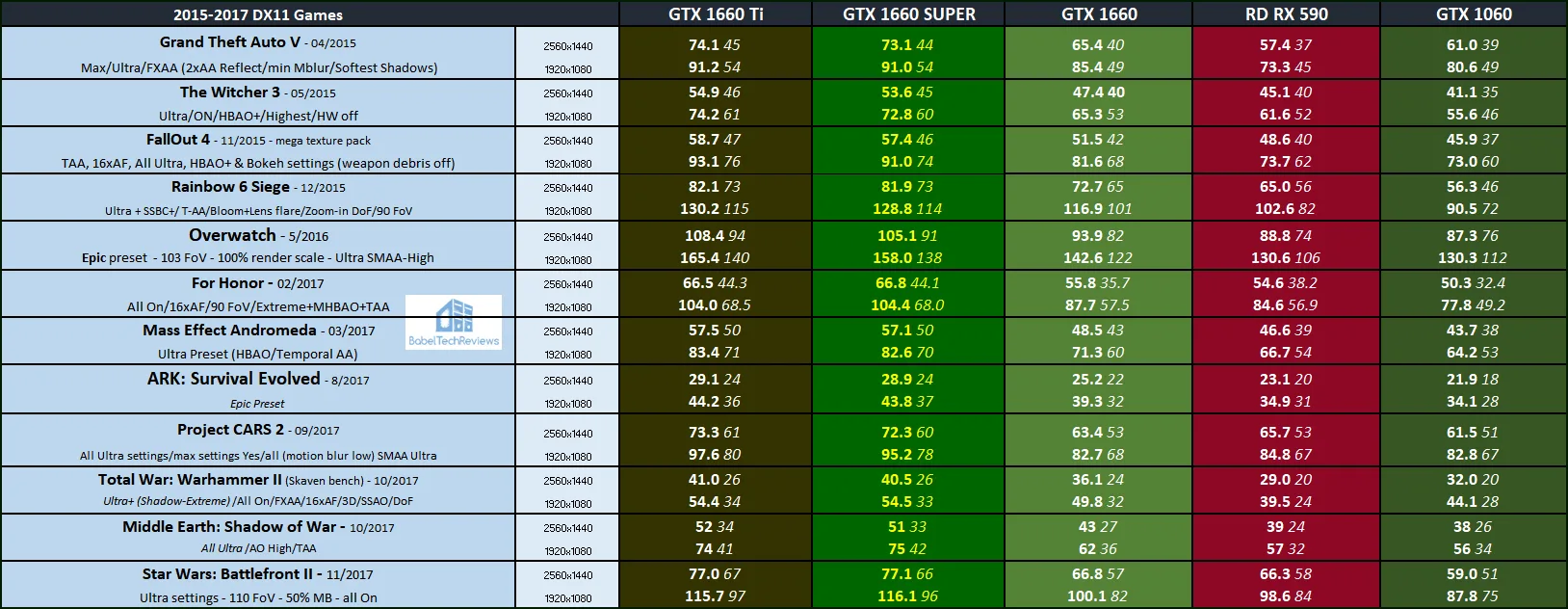The ASUS DUAL GTX 1660 SUPER EVO OC arrives to take on the Red Devil RX 590 in this mega 46-game review
The GTX 1660 SUPER is the eighth GeForce GPU based on NVIDIA’s Turing architecture. Just as with the GTX 1660 Ti, there is no Founders Edition so it is represented in this review by the factory overclocked ASUS DUAL GTX 1660 SUPER EVO OC which launches for sale today at $229.99.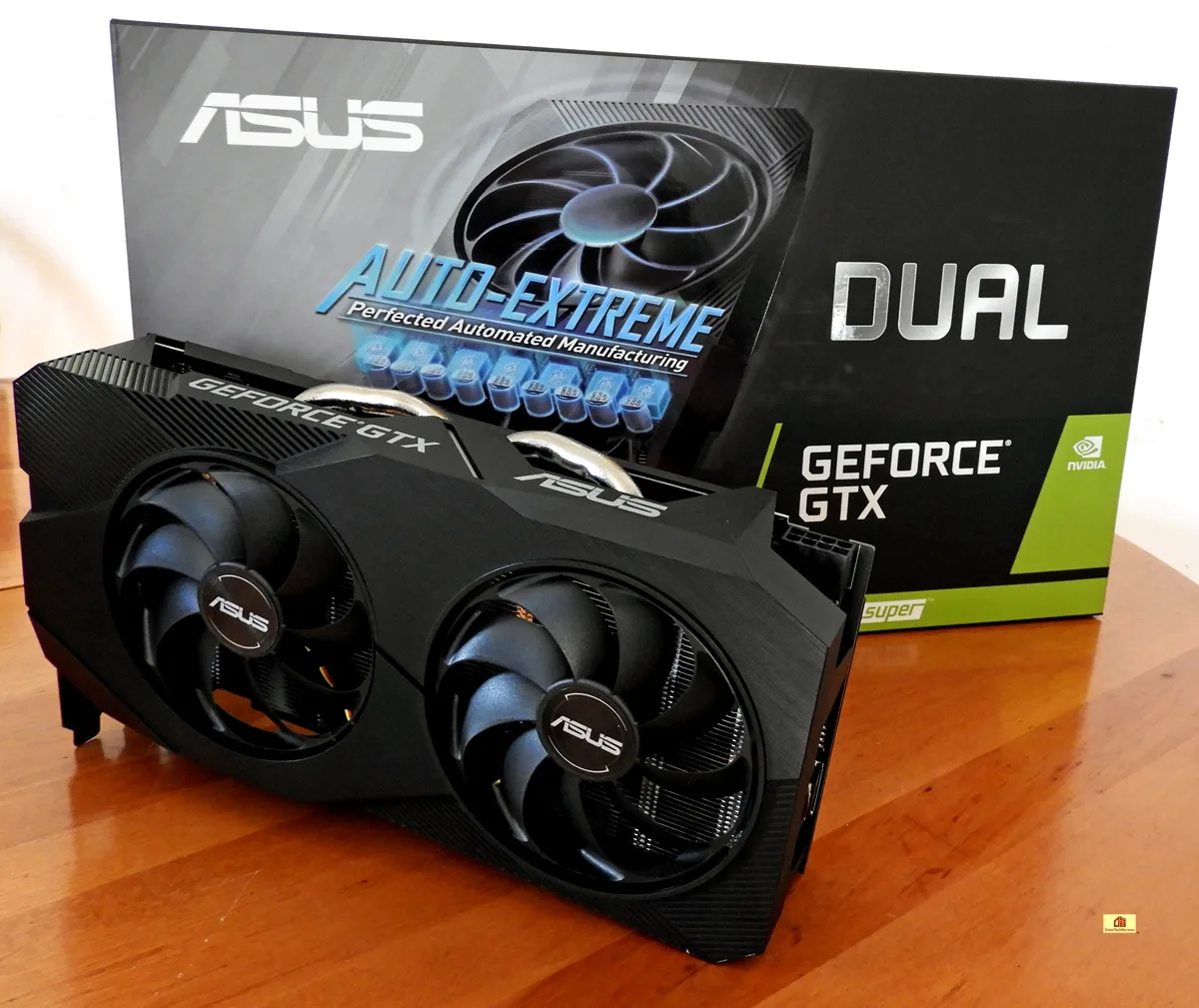
The three Turing 1660s are successors to the Pascal GTX 1060 and they are not equipped with RT nor Tensor cores which allows the GTX 1660 SUPER to launch starting at $229. The GTX 1660 SUPER is currently aimed at the RX 590 which can now be found below $200 with a single game bundle although most overclocked models are priced higher. The Red Devil RX 590 is a premium overclocked card that launched just under a year ago and is currently out of stock at Amazon and Newegg except for open box models priced just below $220, so this is still a fair comparison.
The GTX 1660 SUPER is NVIDIA’s very latest mainstream non-RTX Turing card and it will be available globally today starting at $229 and up for factory-overclocked cards. Performance-wise it will fit in-between the $229 GTX 1660 and the $279 GTX 1660 Ti. The GTX 1660 SUPER has launched at the same price as the vanilla GTX 1660 which will now see a price drop. Clearly NVIDIA is not positioning the new SUPER GTX 1660 against AMD’s current line-up, but is anticipating the upcoming RX 5500 XT and RX 5500. In fact, NVIDIA has announced that the GTX 1650 SUPER will launch on November 22 but has not yet set its pricing.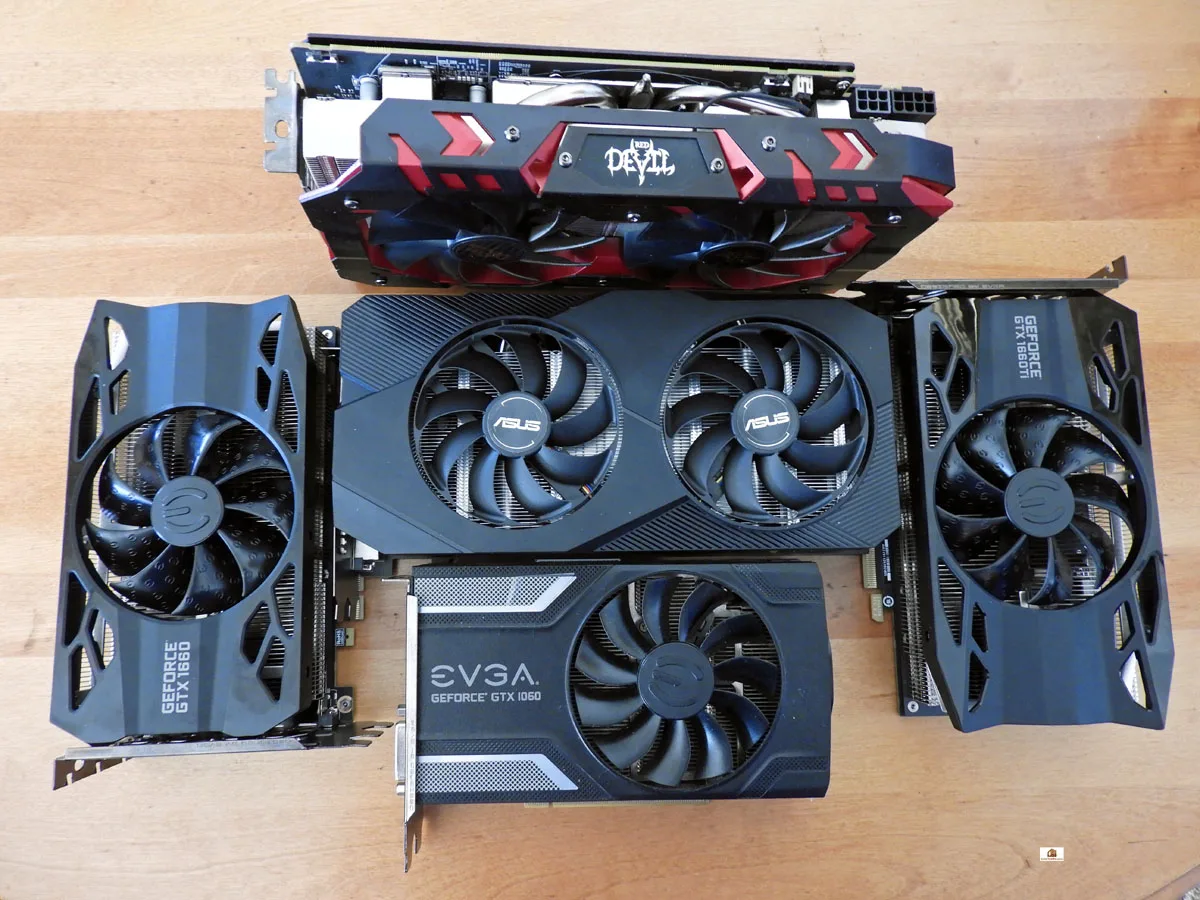
With the release of the GTX 1660 SUPER, NVIDIA has included enhanced tools for image sharpening and scaling in the Control Panel, as well as integrating support for ReShade filters into the GeForce Experience. They have also improved and added an Ultra Low Latency Mode and even more G-SYNC compatible displays. We are covering this separately in a news post about the new 441.08 drivers.
Like the GTX 1060, the GTX 1660, the GTX 1660 Super, and the 1660 Ti each have 6GB of vRAM. We will highlight the GTX 1660 SUPER’s differences between these cards and we will focus on its performance. We will also benchmark it versus the $220 Red Devil RX 590 with an expanded 46-game benching suite which now includes The Outer Worlds, Borderlands 2, Ghost Recon Breakpoint, and Call of Duty: Modern Warfare to see how capable it is at Ultra settings at 1920×1080 and at 2560×1440. We especially want to see how the ASUS DUAL GTX 1660 SUPER EVO OC compares with the last generation Pascal EVGA GTX 1060 SC since NVIDIA claims that the GTX 1660 SUPER is up to 1.5X faster than the GTX 1060.
The GTX 1660, the GTX 1660 SUPER, and the GTX 1660 Ti are all based on the Turing TU116 GPU without tensor nor RT cores so they are less complex and less expensive than the RTX 2060. The GeForce GTX 1660s all feature the Turing core which allow them to exceed Pascal performance in games that use more complex shaders. TU116 includes support for Concurrent Floating Point and Integer Operations, a Unified Cache Architecture with a larger L1 cache, and Adaptive Shading.
The TDP of GTX 1660, SUPER and Ti are each only around 125 watts which make them an easy upgrade from a GTX 970 or GTX 960 as long as the PSU has an 8-pin power connector. Here is NVIDIA’s chart for comparison.
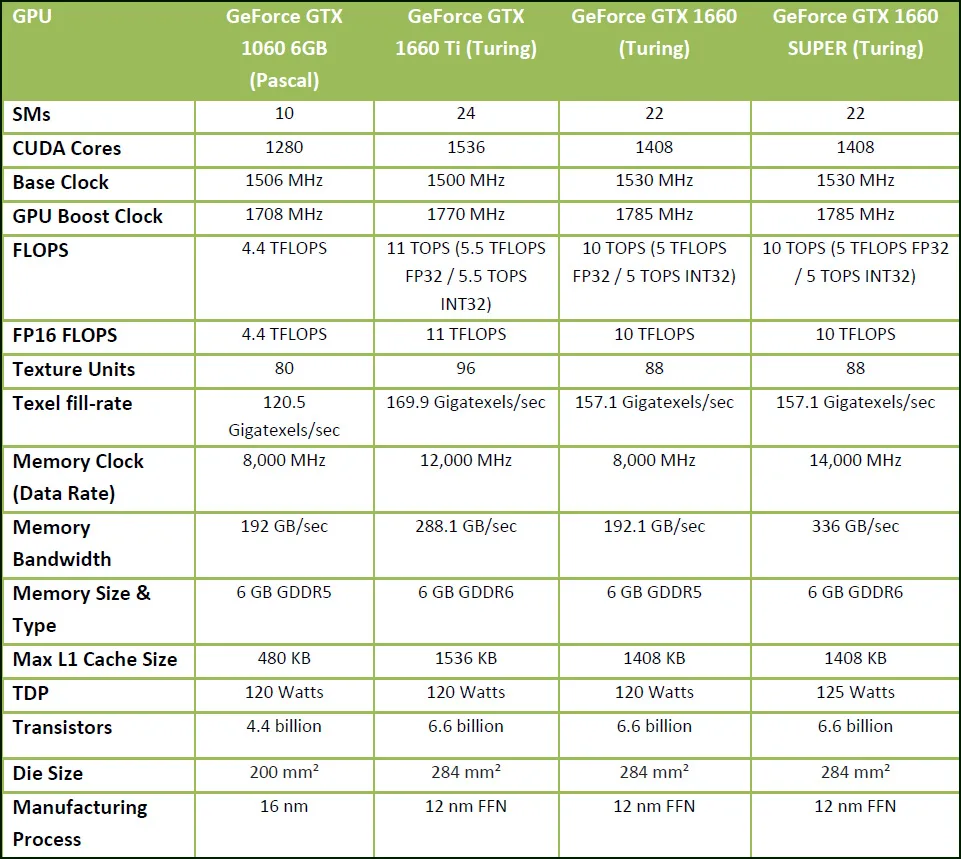
Here are the GTX 1660 SUPER’s specifications featuring 1408 CUDA cores, 88 Texture units, and 48 ROPs. Its base clock is 1530MHz but it will typically boost above 1785MHz. It is equipped with very fast 14Gbps vRAM at 7000MHz on a 192-bit interface.
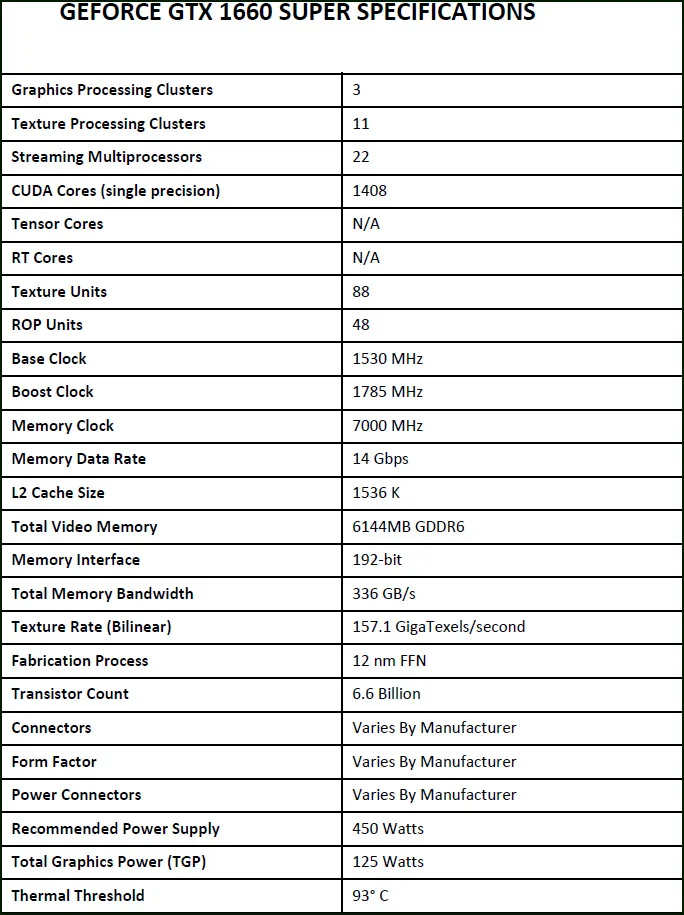
The GTX 1660 Ti features 1536 CUDA Cores and a minimum GPU Boost clock of 1770 MHz as shown by NVIDIA’s chart below.

The GTX 1660 and the GTX 1660 SUPER each have 1408 CUDA cores, cut down from the GTX 1660 Ti’s 1536. While the GTX 1660 Ti uses 6GB of GDDR6, the GTX 1660 uses slower 6GB of GDDR5 memory with a 192-bit memory bus, for a combined memory bandwidth of 192GB/sec which is down considerably from the Ti’s 288.1GB/s and the SUPER’s 336GB/s. Base and Boost clocks are 1530MHz and 1785MHz, respectively which are just a notch up above the Ti’s clocks. The biggest difference between the vanilla GTX 1660 and the GTX 1660 SUPER is the SUPER’s much faster memory and thus much higher memory bandwidth.
Here are the GTX 1660 specifications from NVIDIA’s charts.
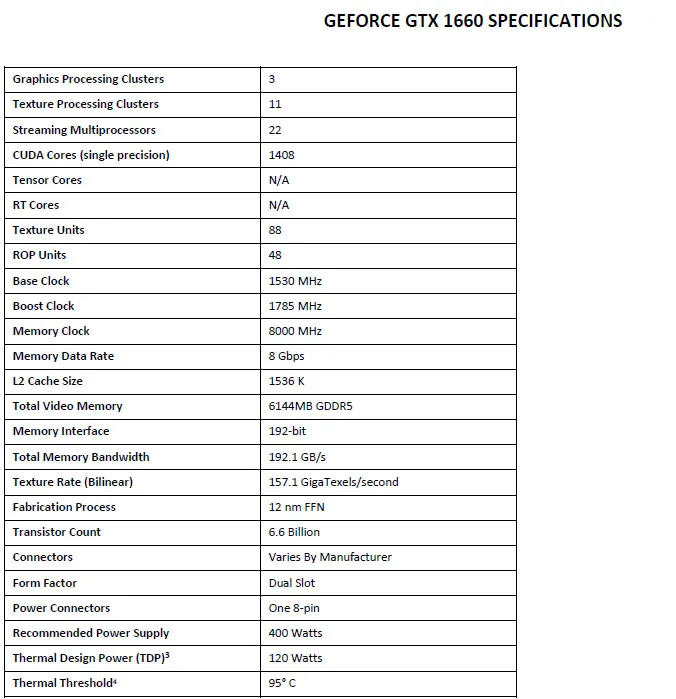
There are five ASUS GTX 1660 SUPER cards, and the card we are testing is in the middle of their stack. The ASUS DUAL GTX 1660 SUPER EVO OC is factory overclocked with a 30MHz offset over the stock core using the Gaming BIOS and 60MHz using the OC BIOS. It also has a Silent BIOS with an advanced onboard controller that brings fans to a stop when the GPU core temperature is below 55 C, letting gamers play undemanding games in relative silence. As the temperatures rise past a predetermined threshold, the fans automatically restart. All of these BIOSes may be accessed by using the ASUS Tweak II utility and further manual overclocking is also available.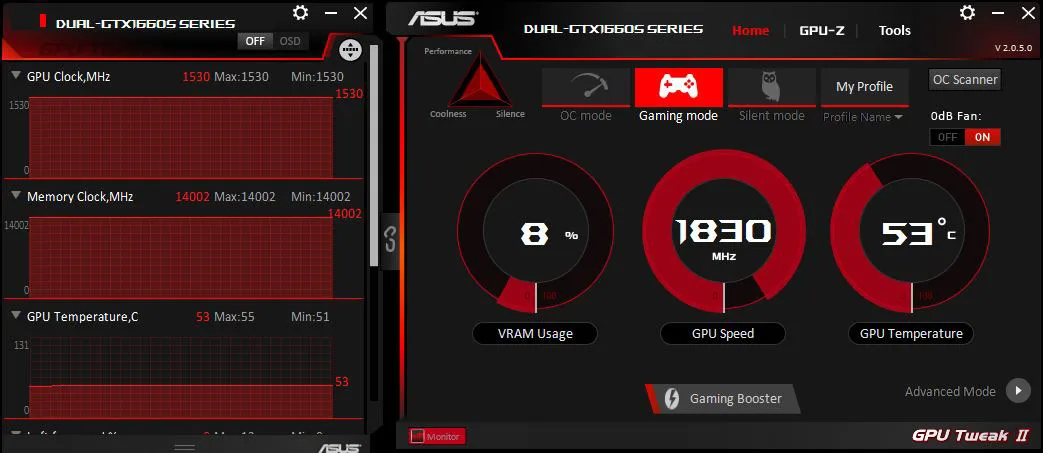
The ASUS DUAL GTX 1660 SUPER EVO OC specifications are as below.
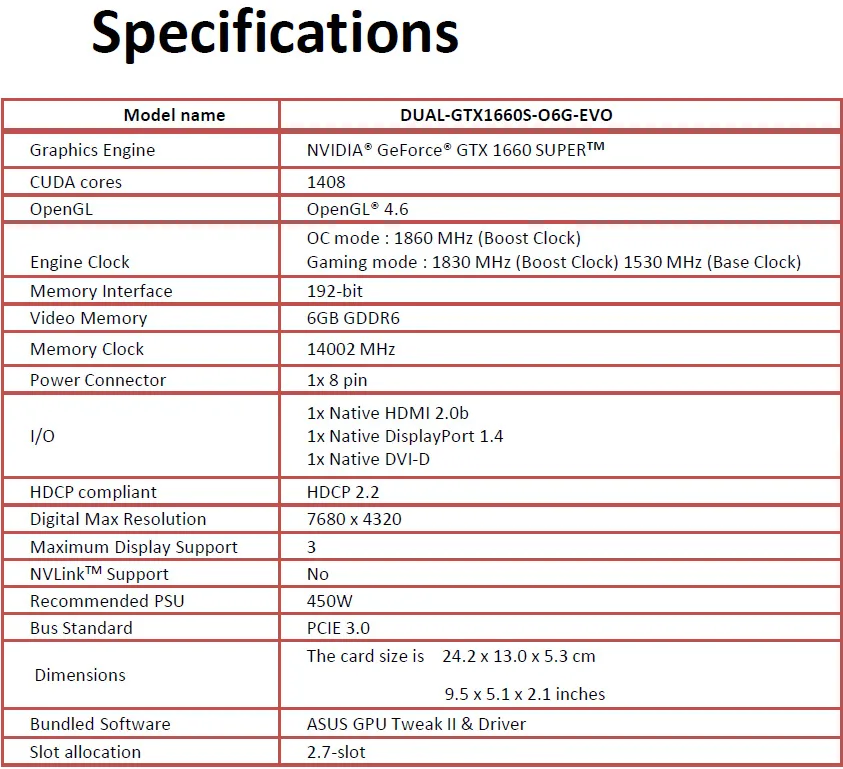
BTR received a DUAL GTX 1660 SUPER EVO OC review sample on an extended loan from ASUS last Tuesday, and we have put it through its paces. We tested all five of our cards with recent drivers on a clean installation of Windows 10 64-bit Home edition, using a Core i7-8700K with all six cores overclocked to 4.8 GHz, and 16GB of T-FORCE 3866MHz DDR4.
First, let’s unbox the ASUS DUAL GTX 1660 SUPER EVO OC.
Unboxing t he ASUS DUAL GTX 1660 SUPER EVO OC
The ASUS DUAL GTX 1660 SUPER EVO OC comes in an large box that advertise its features.
The features are detailed on the back of the box. Axial tech fans are designed for the latest generation of higher end ASUS graphics cards and feature a small hub with longer blades plus a barrier ring to increase downward air pressure and IP5X dust resistance for a long life. ASUS software is also featured with GPU Tweak II as well as XSplit Gamecaster and Quantumcloud for streamers.
Opening the box we see a quick start guide and a thank-you linking the owner to ASUS support.
 Here are the minimum system requirements which include a 450W power supply and an 8-pin cable.
Here are the minimum system requirements which include a 450W power supply and an 8-pin cable.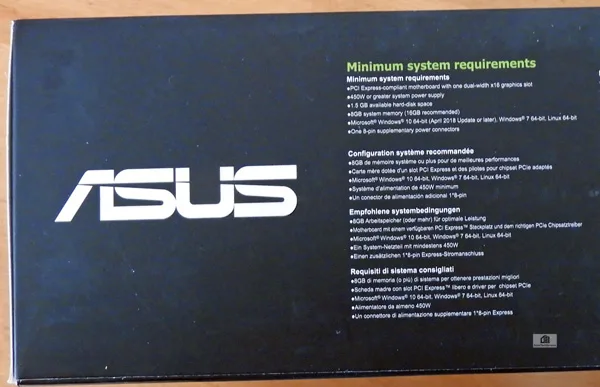 The ASUS DUAL GTX 1660 SUPER EVO OC is a good-looking 2.7 slot dual-fan card.
The ASUS DUAL GTX 1660 SUPER EVO OC is a good-looking 2.7 slot dual-fan card.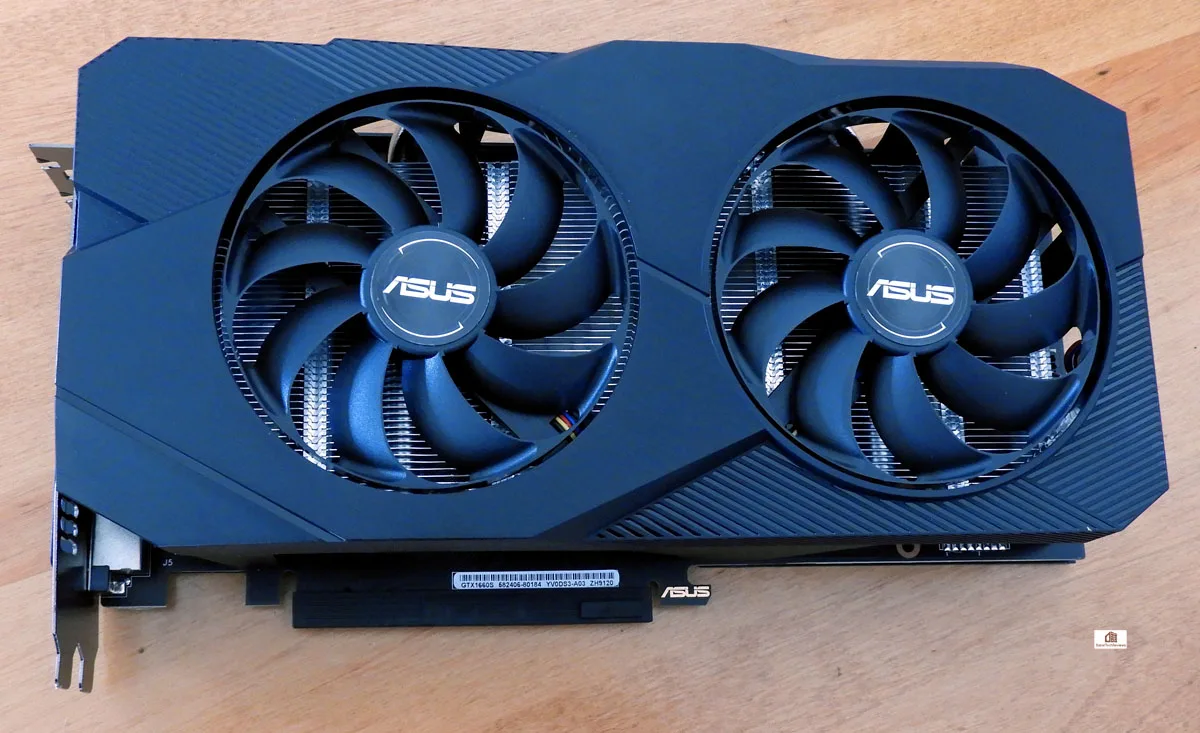
Turning it over, we see a solid metal backplate that protects the PCB against flexing and prevents damaging the traces.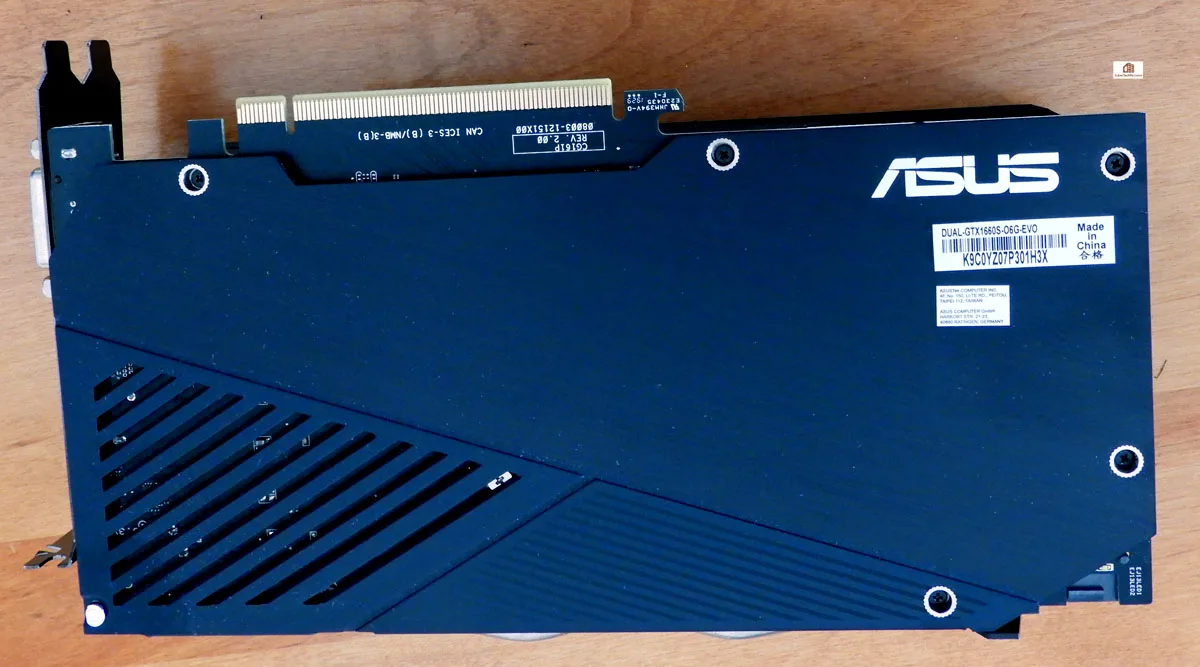 Looking at the ASUS DUAL GTX 1660 SUPER EVO OC from its edges we see the dual heatpipes that use DirectCU II which brings copper heatpipes into direct contact with the die for better cooling, and the large heatsink that extends for much of the length of the PCB.
Looking at the ASUS DUAL GTX 1660 SUPER EVO OC from its edges we see the dual heatpipes that use DirectCU II which brings copper heatpipes into direct contact with the die for better cooling, and the large heatsink that extends for much of the length of the PCB.
 Here is one end.
Here is one end.
On the other end, the connectors consist of a DisplayPort, a HDMI connector, and a DVI connector. 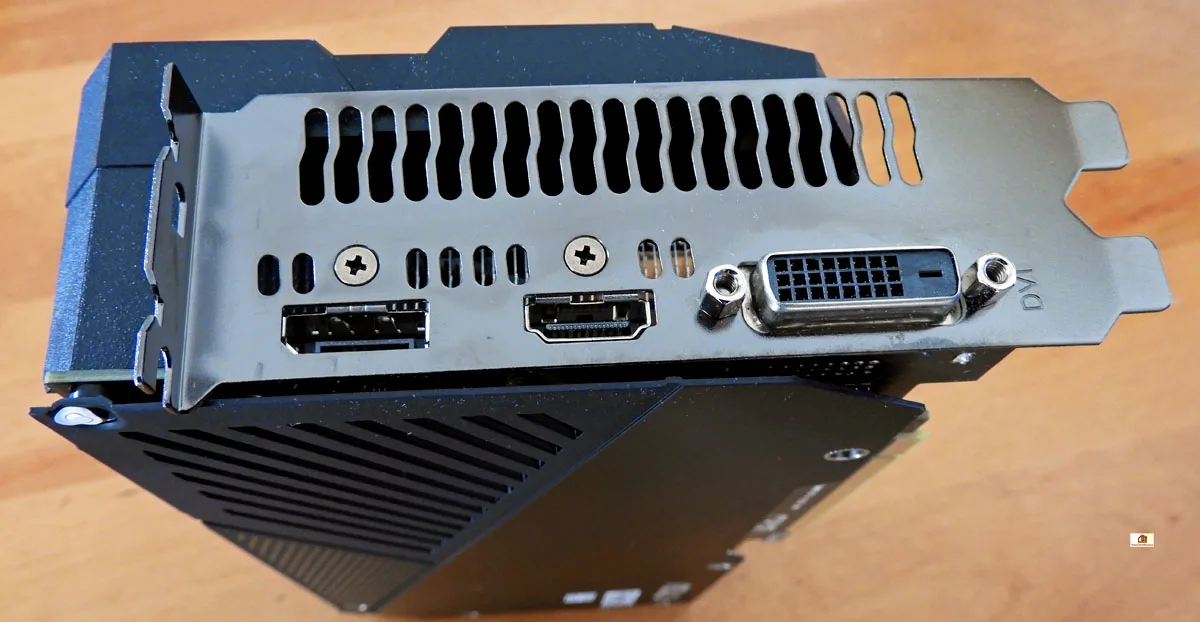
ASUS Auto-Extreme Technology and Testing
ASUS graphics cards are produced using Auto-Extreme Technology, an automated manufacturing process that allows all soldering to be completed in a single pass to reduce thermal strain on components while avoiding the use of harsh cleaning chemicals. Here is their video.
ASUS’ validation program puts their cards through a series of tests. Each card must meet rigorous performance and
reliability standards before it ships. Performance and stress tests are run and reliability trials include a 144 hour stability test and a series of 3DMark benchmarking runs to ensure the card performs well at their limits.
The card looks great. But before we explore overclocking and then performance testing, let’s take a closer look at our test configuration.
Test Configuration – Hardware
- Intel Core i7-8700K (HyperThreading and Turbo boost is on to 4.8GHz for all cores; Coffee Lake DX11 CPU graphics).
- EVGA Z370 FTW motherboard (Intel Z370 chipset, latest BIOS, PCIe 3.0/3.1 specification, CrossFire/SLI 8x+8x), supplied by EVGA
- T-FORCE 16GB DDR4 (2x8GB, dual channel at 3866 MHz), supplied by Team Group
- ASUS DUAL GTX 1660 SUPER EVO OC, on loan from ASUS
- EVGA GTX 1660 XC Gaming 6GB, stock GTX 1660 Ti clocks, on loan from EVGA
- EVGA GTX 1660 Ti Black 6GB, at factory clocks, on loan from EVGA
- EVGA GTX 1060 SC 6GB, factory SC clocks, on loan from EVGA
- Red Devil RX 590 8GB, at factory overclocked settings, on loan from PowerColor
- 2 x 480GB Team Group SSDs – one for AMD, and one for NVIDIA
- 1.92TB San Disk enterprise class SSD
- 2TB Micron 1100 enterprise class SSD
- 500GB Vulkan SSD, supplied by Team Group
- Seasonic 850W Gold Focus power supply unit
- EVGA CLC 280mm CPU water cooler, supplied by EVGA
- EVGA Nu Audio PCIe soundcard, supplied by EVGA
- Edifier R1320T Active speakers
- EVGA DG-77, mid-tower case supplied by EVGA
- LG 43″ HDR 4K TV
- Monoprice Crystal Pro 4K
Test Configuration – Software
- GeForce 436.48 drivers used for the GTX 1060 SC. Game Ready 440.77 drivers are used for the GTX 1660 and the GTX 1660 Ti. Press launch drivers 441.77 are used for the ASUS DUAL GTX 1660 SUPER EVO OC. See NVIDIA Control Panel image below.
- AMD Adrenalin Software 19.10.2 is used for the Red Devil RX 590. See the AMD Control Panel image below.
- VSync is forced off.
- AA enabled as noted in games; all in-game settings are specified with 16xAF always applied
- Gaming results show average frame rates in bold including minimum frame rates shown on the chart next to the averages in a smaller italics font where higher is better. Games benched with OCAT show average framerates but the minimums are expressed by the 99th percentile frametime in ms where lower numbers are better.
- Highest quality sound (stereo) used in all games.
- Windows 10 64-bit Home edition. DX11 titles are run under DX11 render paths. DX12 titles are generally run under the DX12 render path unless performance is lower than with DX11, and Borderlands 3, Total War Warhammer II and Hitman 2 are tested on DX11 and on DX12. Four games use the Vulkan API.
- Latest DirectX
- All 46 games are patched to their latest versions at time of posting.
- WattMan used to set Radeon cooling and power options.
- Afterburner used for GeForce settings and primarily for overclocking the ASUS DUAL GTX 1660 SUPER EVO OC
- ASUS GPU Tweak II
- OCAT, latest version
- Fraps, latest version
- FrameView, latest beta
- Unigine Heaven 4.0 benchmark
46 PC Game benchmark suite & 3 synthetic tests
Synthetic
- Firestrike – Basic & Extreme
- Time Spy DX12
- Superposition
DX11 Games
- Grand Theft Auto V
- The Witcher 3
- Fallout 4
- Rainbow Six Siege
- Overwatch
- For Honor
- Mass Effect: Andromeda
- ARK: Survival Evolved
- Project CARS 2
- Total Wars: Warhammer II
- Middle Earth: Shadow of War
- Star Wars: Battlefront II
- Monster Hunter: World
- Kingdom Come: Deliverance
- Final Fantasy XV
- Far Cry 5
- Conan Exiles
- Assassin’s Creed: Odyssey
- Call of Duty: Black Ops 4
- Hitman 2
- Just Cause 4
- Resident Evil 2
- Anthem
- FarCry New Dawn
- Devil May Cry 5
- Borderlands 3
- Destiny 2 Shadowkeep
- Ghost Recon Breakpoint
- The Outer Worlds
DX12 Games
- Civilization VI
- Sniper Elite 4
- Forza 7
- Total War: Warhammer II
- Total War: Vermintide 2
- Shadow of the Tomb Raider
- Hitman 2
- Battlefield V
- Metro Exodus
- Tom Clancy’s The Division 2
- Anno 1800
- F1 2019
- Control
- Gears 5
- Borderlands 3
- Call of Duty Modern Warfare
Vulkan Games
- DOOM
- Strange Brigade
- World War Z
- Wolfenstein: Youngblood
AMD Adrenalin Control Center Settings
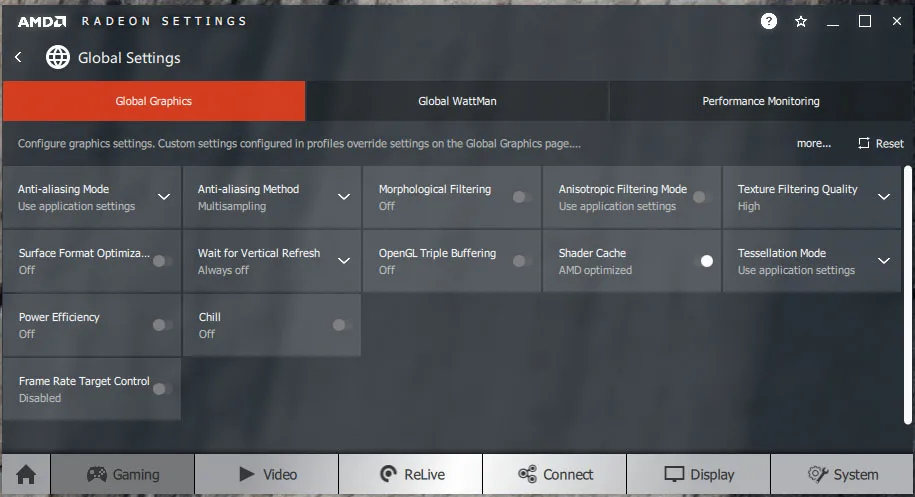 All AMD settings are set so as to be apples-to-apples when compared to NVIDIA’s control panel settings – all optimizations are off, Vsync is forced off, Texture filtering is set to High, and Tessellation uses application settings.
All AMD settings are set so as to be apples-to-apples when compared to NVIDIA’s control panel settings – all optimizations are off, Vsync is forced off, Texture filtering is set to High, and Tessellation uses application settings.
We use Wattman to set the RX 590’s power, temperature, and fan settings to their maximums.
NVIDIA Control Panel settings
Here are the NVIDIA Control Panel settings that match AMD’s settings.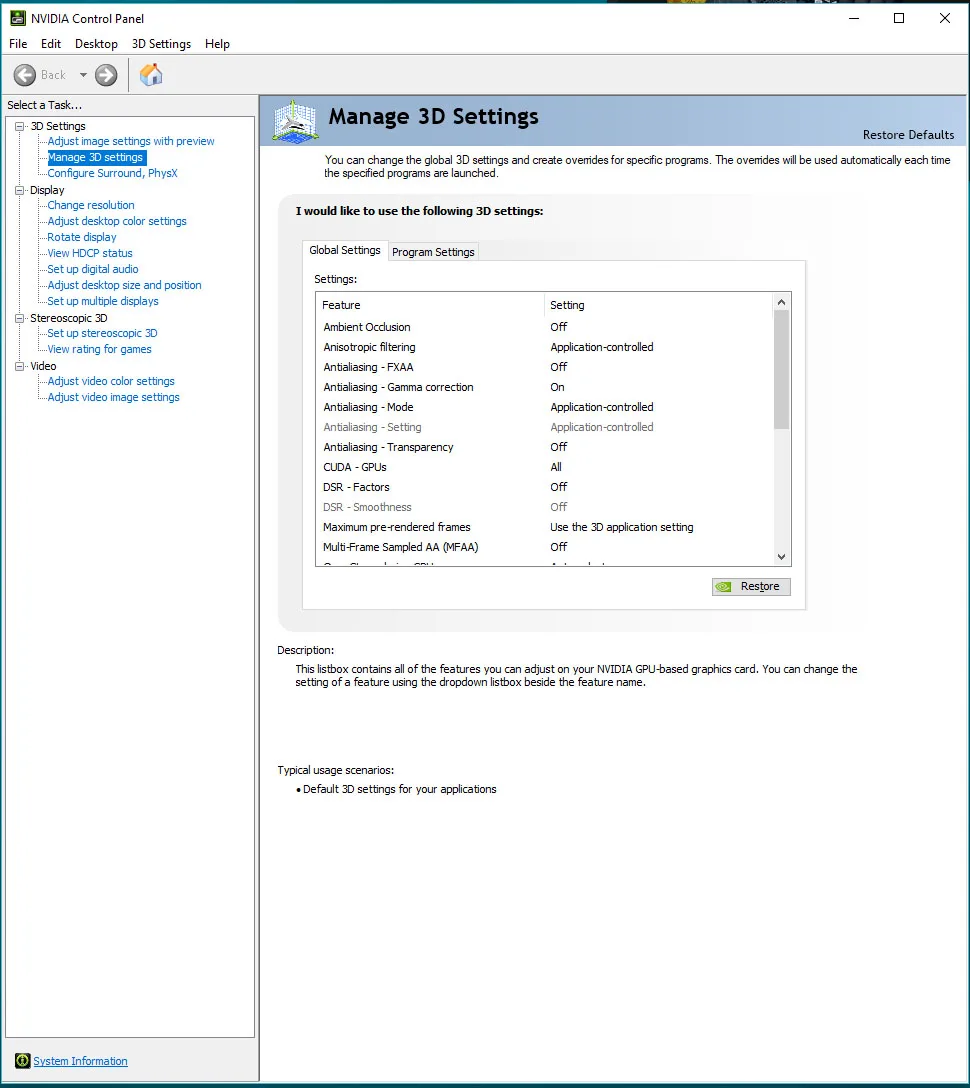
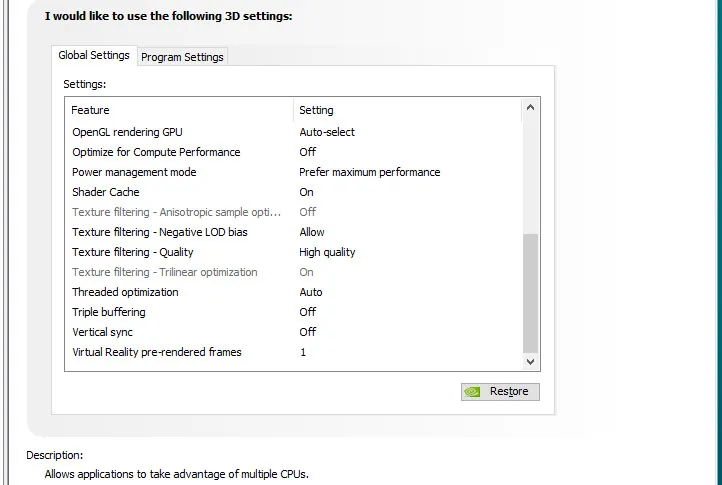 We used the latest beta of Afterburner to set all GeForces’ highest Power and Temperature targets and for our primary overclock of the ASUS DUAL GTX 1660 SUPER EVO OC.
We used the latest beta of Afterburner to set all GeForces’ highest Power and Temperature targets and for our primary overclock of the ASUS DUAL GTX 1660 SUPER EVO OC.
By setting the Power Limits and Temperature limits to maximum for each card, they do not throttle, but they can each reach and maintain their individual maximum clocks more easily and it benefits the RX 590 as much as it does the GeForce cards. There is almost no performance differences between using these and stock clocks although it gives more consistent benchmark results.
Let’s check out overclocking, temperatures, and noise next.
Overclocking, temperatures & noise
The ASUS DUAL GTX 1660 SUPER EVO OC is a low-power and quiet card even when overclocked. We could not hear the card over the fans of our PC even when it ramps up, unlike with the Red Devil RX 590. We will spend much more time manually overclocking and testing performance in our follow-up overclocking showdown versus the GTX 1660 Ti.
The ASUS Tweak II utility has three basic profiles – (1) Silent mode with a boost of 1800MHz; (2) Gaming mode with a boost of 1830MHz; and (3) OC Mode with a boost of 1860MHz. In addition, the User1 mode allows for manual overclocking with a myriad of options including the built-in OC Scanner for automatic overclocks.

Here is Heaven 4.0 running at stock clocks which allowed the Boost to stay locked at 1935MHz which is well above NVIDIA’s typical boost of 1785MHz for a reference clocked GTX 1660 SUPER.
Since we have a lot more experience using Afterburner, we reached a final stable overclock of 2100MHz by adding +165MHz to the ASUS DUAL GTX 1660 SUPER EVO OC core’s offset. The vRAM is also highly overclockable as we were able to add +850MHz to the memory clocks to reach 7850MHz resulting in a nice performance boost.
As you can see, the card stayed cool and below 73C even when overclocked to its maximum and the dual fans never became intrusive.
Let’s check the ASUS DUAL GTX 1660 SUPER EVO OC’s performance compared with four other cards using 46 games, and then head for our conclusion.
Performance Summary Charts
Here are the summary charts of 46 games and 3 synthetic tests. The highest settings are always chosen and the settings are listed on the chart. The benches were run at 1920×1080 and at 2560×1440. Five cards are featured and benchmarked.
Most results show average framerates and higher is better. Minimum framerates are next to the averages in italics and in a slightly smaller font. The games benched with OCAT show average framerates but the minimums are expressed by the 99th percentile frametime in ms where lower numbers are better.
The Main Performance Charts
This set of charts show our five main competing cards’ performance from fastest to slowest. The stock-clocked EVGA GTX 1660 Ti Black is in the first column with the ASUS DUAL GTX 1660 SUPER EVO OC in the second column in gold text. The factory overclocked EVGA GTX 1660 XC is in the third column and the Red Devil RX 590 is in the fourth. Finally, the GTX 1060’s performance is in the last column
All four of the competing tested cards are in a similar class, but the GTX 1660 SUPER wins almost all of the games against the RX 590. Out of 45 games, the Red Devil RX 590 only wins in 2.5 games against the ASUS DUAL GTX 1660 SUPER EVO OC. The RX 590 mostly wins against the GTX 1060 but it trades blows with the GTX 1660 with the Radeon losing more games than it wins. Interestingly the ASUS DUAL GTX 1660 SUPER EVO OC performs just below the EVGA GTX 1660 Ti Black – generally below 5%.
Although the ASUS GTX 1660 SUPER is a mildly factory-overclocked card and the EVGA GTX 1660 Ti is a stock card, it may be difficult to justify the extra fifty dollars that the Ti commands when both cards are tested at their stock factory settings. However, it will be very interesting to see if the Ti can pull away from the SUPER when both are overclocked to the max, and our follow up review later this week will cover this.
The older generation EVGA GTX 1060 SC offers significantly less performance than the ASUS DUAL GTX 1660 SUPER EVO OC, and it seems to support NVIDIA’s claim that the GTX 1660 SUPER is up to 1.5X faster, especially in modern games with complex shaders. The Red Devil RX 590 is beaten even more solidly now by a $229 card and AMD needs to bring out the RX 5500 XT and/or drop the price on the RX 590.
We tested Call of Duty: Modern Warfare on our GeForce cards with ray traced shadows on versus off, and it is interesting to see that ray traced shadows are marginally playable on both the GTX 1660 Ti and SUPER each averaging around 50 FPS although the minimums are too low for ultra settings even at 1920×1080. If a player really wants to play with ray traced shadows on, then it is best to upgrade to a RTX 2060 (or higher) that uses dedicated cores for ray tracing. The RTX 2060 can evidently play above 60 FPS/highest settings/1080p with ray tracing enabled and we will performance test Call of Duty: Modern Warfare next week with the RTX cards.
This has been an unbelievably hectic and short yet enjoyable exploration evaluating the new Turing GTX 1660 SUPER as represented by the ASUS DUAL GTX 1660 SUPER EVO OC. It performed very well compared with the nearly $50 more expensive EVGA GTX 1660 Ti Black.
Although NVIDIA has bet their gaming future on introducing RTX features including DLSS and ray tracing, their strategy appears to be to use these features for their more powerful cards beginning with the RTX 2060. The GTX 1660 was reasonably priced at $229 which is $20 less than the launch price of the GTX 1060 at $249, but the more powerful GTX 1660 SUPER has also launched at $229 making it far more attractive now. The GTX 1660 SUPER is a decent performance upgrade from a GTX 1060 and it would be a great upgrade for a GTX 960 or GTX 970 owner as can be seen in BTR’s GTX 1660 review.
Conclusion

We are impressed with this 125W single 8-pin PCIe cabled mainstream Turing GTX 1660 SUPER that has solid performance at ultra 1920×1080. The ASUS DUAL GTX 1660 SUPER EVO OC is priced at a very reasonable $229 – the same price as the vanilla GTX 1660 that it outperforms, and it is significantly faster than the $220 Red Devil RX 590. For a gamer looking for best bang-for-buck 1080P performance, the ASUS DUAL GTX 1660 SUPER EVO OC is a very good deal as it has a factory overclock with great cooling, a nice metal backplate, looks great in any PC, and it is backed by ASUS’ 3-year warranty.
The ASUS DUAL GTX 1660 SUPER EVO OC is quiet, well-built, solid, good-looking, and it overclocks very well. In our case, we overclocked our review sample to 2100MHz plus a +850MHz offset to its memory. Our follow-up review featuring the ASUS DUAL GTX 1660 SUPER EVO OC versus the EVGA GTX 1660 Ti Black manual overclocking showdown will be posted by this weekend.
Pros
- The ASUS DUAL GTX 1660 SUPER EVO OC is a fast Ultra/1080P mainstream card that is even suitable for High/1440P. It performs much better than the similarly-priced premium Red Devil RX 590, and at $229 it launches at the same price as the slower vanilla GTX 1660.
- The ASUS DUAL GTX 1660 SUPER EVO OC performs within less than 5% of the almost $50 more expensive EVGA GTX 1660 Ti Black
- Overclocking headroom is very good.
- The ASUS DUAL GTX 1660 SUPER EVO OC is quiet and efficient using only 125W and a single 8-pin connector. The card stays cool and quiet even when overclocked to the max.
- 0db Silent Mode for light silent gaming as well as two other presets offer flexibility to any gamer plus full manual control over overclocking.
- Although it is factory overclocked with a solid backplate and accent lighting, there is no price premium over an entry-level GTX 1660 SUPER.
- GPU Tweak II offers great monitoring and overclocking features.
- ASUS offers a 3 year warranty.
Cons
- None
The Verdict
If you are buying a fast mainstream 1080P video card right now, the ASUS DUAL GTX 1660 SUPER EVO OC is a great choice at $229. The GTX 1660 SUPER is faster than any factory overclocked premium RX 590, and it is priced the same as the slower GTX 1660 which will get a price drop. Amazingly, the ASUS card performs within less than 5% of a GTX 1660 Ti but it is priced about $50 less.
 We would like to award the ASUS DUAL GTX 1660 SUPER EVO OC BabelTechReviews’ Good Value Award for what is essentially the best value in its class.
We would like to award the ASUS DUAL GTX 1660 SUPER EVO OC BabelTechReviews’ Good Value Award for what is essentially the best value in its class.
The ASUS DUAL GTX 1660 SUPER EVO OC brings a well-priced mainstream addition to the GeForce Turing GTX family. A gamer can be assured of immersive gaming by picking this card for Ultra/1080P or perhaps even for entry-level VR or High/1440P gaming. If you currently game on an older generation video card such as a GTX 960, GTX 970, or even a GTX 1060, you will do yourself a favor by upgrading to a GTX 1660 SUPER.
Stay tuned, there is a lot more coming from us at BTR. We will shortly pit the EVGA GTX 1660 Ti Black versus the ASUS DUAL GTX 1660 SUPER EVO OC in an overclocking showdown by this weekend. We also expect to post a VR review featuring the Vive Pro that explores performance headroom, and then we will explore VR using the new GTX 1660 SUPER.
Tell us what you think in the comments below or on BTR’s forum.
Happy Gaming!
